Berry & vegetable farm confined spaces
Because of toxic gases and other hazards, working in confined spaces on berry and vegetable farms can be dangerous. It is important to fully understand the hazards before entering the space.
Below, you'll find general information to help you assess the hazards of confined spaces on berry and vegetable farms. Please note: there may be confined spaces on your farm that are not listed here.
The hazards
Cardboard compactors use hydraulic systems to crush cardboard and apply wire bindings. The operator dumps cardboard into the hopper and a hydraulic ram compresses the material. Depending on its size, the hopper may be a confined space.
| Hazards | Hazardous work |
|
|
 |
 |
Cardboard compactors
Without proper ventilation, crawl spaces or cellars can be dangerous. Lack of oxygen or toxins in the air are possible hazards. In small spaces, the combination of metal and moisture (causing rust) can deplete the oxygen supply. Other toxic gases may also accumulate, depending on building use above the crawl space or material being stored in the space.
| Hazards | Hazardous work |
|
|
 |
 |
Exterior entrance and crawl space
Irrigation pump stations draw water from surface sources such as ditches, streams, ponds, or lakes. The water source may be flowing or stagnant. The bottom of stagnant water sources can contain accumulated sludge.
On some farms, water enters into chambers in the pump station where a there is a pump intake or pipes leading to the intake. The pump station may have additional chambers for directing water flow. On other farms, the pump — and sometimes the pump station building — sit above the water.
| Hazards | Hazardous work |
|
|
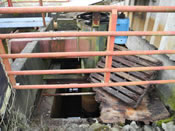
Irrigation pump station
Load levellers at the edge of loading docks adjust the ramp height between the bed of the truck or transport trailer and a structure's floor. The levelling mechanism is often hydraulically powered, though some loaders are spring-loaded. The enclosure formed between the levelling ramp and concrete loading dock may be a confined space.
| Hazards | Hazardous work |
|
|
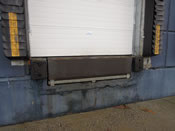
Load leveller
Mobile equipment used on berry and vegetable farms may include:
- Mixers (e.g., for mixing feed)
- Spreaders (e.g., for fertilizers)
- Tank wagons (e.g., for pesticides, fertilizers, and liquid manure)
Mixers and spreaders contain moving mechanical parts. Workers may be at risk of injury or death if they fall into the operating machinery or if mechanical equipment is not properly locked out. To help reduce the risk, choose (or retrofit) equipment that doesn't require entry to mixers or spreaders.
Tanks may contain toxic gases or vapours from fermenting material, such as liquid manure, as well as aerosols from pesticides. Some of these may be toxic and can quickly cause death if they are inhaled at high concentrations, which is much more likely in a confined space. Some cleaning chemicals can also produce very toxic gases. Low oxygen conditions may occur if a tank has been empty for a while.
| Hazards | Hazardous work |
|
|
 |
 |
 |
| Tank wagon | Mobile sprayer | Mobile sprayer |
Refrigeration is used to preserve berries and vegetables during storage and transport. Refrigerant is cooled in a dedicated compressor room and transferred through piping to the cooling location. Refrigeration systems use ammonia or halogenated hydrocarbons as refrigerants. The compressor room contains vessels for storing ammonia.
Mechanical fan cooler units are located in the cooler or freezer warehouses near roof level. Flash freezers are used for rapid cooling. Some fan coolers and flash freezers are large enough to enter.
| Hazards | Hazardous work |
|
|
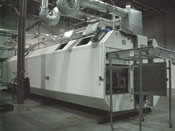
Flash freezer
Berry and vegetable farms in rural areas are not part of municipal sanitary collection systems. These operations require standalone sewage treatment facilities, including collection and processing chambers. In these confined spaces, wastewater treatment can result in low-oxygen conditions and produce toxic gases. Inhaling these toxic gases at high concentrations can rapidly cause death.
| Hazards | Hazardous work |
|
|
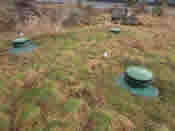
Septic tank hatches
A pump station, also known as a lift station, is a below-ground chamber that collects drainage from surface and subsurface sources. Pumps move the liquid to a higher level, which may include an above-ground storage tank, drainage structure, or sewer.
Pump stations on berry and vegetable farms handle drainage from the processing area and sanitary system. This water contains organic debris from plant parts. Pump stations may also handle relatively clean water collected from roofs and other sources, and surface drainage for transfer to ditches.
As the pump works it can release toxic gases as it agitates the sludge. Agitation thins the fluid and creates bubbles and foam, releasing gas into the air. High concentrations of these gases can cause death in a few seconds.
To help reduce the risk, choose (or retrofit) equipment so station entry is not required to perform maintenance or repairs.
| Hazards | Hazardous work |
|
|
 |
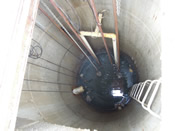 |
| Lift station hatchway | Lift station |
Sumps are below-ground chambers that collect drainage from surface and subsurface sources. When the trap in the outflow pipe overflows, collected water is then transferred to another location through the outflow pipe. Sumps act as separation chambers before discharging to stormwater drainage. Stormwater manholes serve the same function, but may not include the separation capability.
On berry and vegetable farms, sumps can accumulate organic matter in runoff from various sources. Sludge can trap gases from anaerobic digestion. Agitation thins the sludge and releases these gases. Fermentation gases are toxic and can rapidly cause death when inhaled at high concentrations.
| Hazards | Hazardous work |
|
|
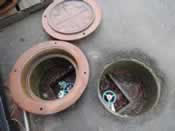
Stormwater manhole and drains
Some refrigeration equipment incorporates vacuum/evaporative cooling. The vacuum increases the evaporation rate. The equipment contains a vacuum system, water spraying, and may include refrigeration. The interior of the cooling structure includes a track for moving produce on a rack.
| Hazards | Hazardous work |
|
|

Evaporative cooler
Storage tanks often hold potable water for washing produce. Normally, hazardous gases will not be present in a water tank as long as the water is clean. However, biofilm and sludge can form inside the tank. Some cleaning and disinfecting chemicals can produce very toxic gases, even in very low quantities.
Low-oxygen conditions may also occur if the tank has been empty for some time. The greatest risk is from drowning, which can occur in as little as 15 cm of water.
| Hazards | Hazardous work |
|
|
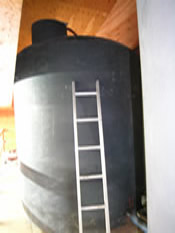
Water tank
A well pit is the chamber at the top of a wellhead. If the chamber located under the floor of a building, it is considered a confined space. The well pit provides access to the well and pumping equipment. It also prevents freeze-up in the pressure tank and piping.
Normally, hazardous gases won't be present in a well provided there's very little (or no) organic material in the water. However, oxygen depletion can occur when metal rusts. This is most likely when the well pit is closed for a long time and condensation forms on metal surfaces.
| Hazards | Hazardous work |
|
|
 |
 |
Well pits
Highlights
- New risk advisory on the dangers of fire and explosion in asphalt mix plants Published on: August 15, 2023
- New online tool helps workers and employers manage risk by delivering a custom list of health and safety resources Published on: December 05, 2022
- New slide show highlights the importance of protecting workers from the hazards of confined spaces in agriculture Published on: August 29, 2022

